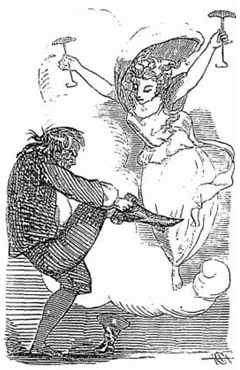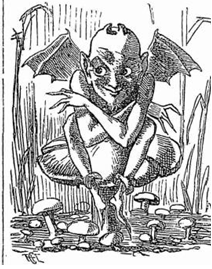 The illustrator and watercolourist Helen Hoppner Coode was the first known female contributor to Punch. According to M.H. Spielmann she contributed nineteen drawings between November 1859 and January 1861.1 All of the drawings that I have been able to find with her signature on them are illuminated letters or small sketches accompanying articles. I have not yet been able to find any evidence of how she became involved with Punch but, judging from the stories of other nineteenth-century female Punch contributors, it was probably due to a social or family connection with a member of the Punch staff.
The illustrator and watercolourist Helen Hoppner Coode was the first known female contributor to Punch. According to M.H. Spielmann she contributed nineteen drawings between November 1859 and January 1861.1 All of the drawings that I have been able to find with her signature on them are illuminated letters or small sketches accompanying articles. I have not yet been able to find any evidence of how she became involved with Punch but, judging from the stories of other nineteenth-century female Punch contributors, it was probably due to a social or family connection with a member of the Punch staff.
At around the same period that she was drawing for Punch, Coode also contributed illustrations to Once a Week.2 She was a member of the Society of Female Artists and she often contributed work to their exhibitions.3 She also exhibited work in Manchester, at the British Institution, and at the Royal Academy between 1859 and 1882.4 She published at least one book, a collection of short stories called The Strange Story of Eugenia, The Necromancer’s Hand, &c., in 1885, which she wrote and illustrated.5 The reviewer in The Academy, described this book as a ‘shilling dreadful’, suggesting that it had sensational themes and was not very literary.6
Little is known about Coode’s personal life but census returns reveal that she was born in approximately 1834 and that her parents were George Coode, a barrister, and Helen Coode. She had at least three younger sisters and one younger brother. She remained  unmarried throughout her life. As an adult she lived with her widowed mother, her sister Violet, who was also unmarried, and later her widowed sister Rosa. She appears to have continued working into her old age. In the 1911 census, when she was 77, she gave her occupation as ‘Writer and Painter (Art)’.7
unmarried throughout her life. As an adult she lived with her widowed mother, her sister Violet, who was also unmarried, and later her widowed sister Rosa. She appears to have continued working into her old age. In the 1911 census, when she was 77, she gave her occupation as ‘Writer and Painter (Art)’.7
Although her contribution to Punch was fairly small and short-lived, Coode’s status as the first female Punch contributor (as far as we know, given the records that are left to us) makes her a significant figure for anyone with an interest in women and Punch.
- M.H. Spielmann, The History of “Punch” (London, Paris and Melbourne: Cassell and Company Limited, 1895), p. 502.
- Simon Houfe, The Dictionary of 19th Century British Book Illustrators (Woodbridge, Suffolk: The Antique Collectors’ Club, 1996), p. 97.
- See, for example, ‘The Society of Female Artists’, Athenaeum 1897 (5th March 1864), pp. 342-3; ‘Society of Female Artists’, Athenaeum 2048 (26th Jan 1867), p. 125; ‘Society of Female Artists’, Art Journal (March 1867), p. 88.
- Houfe, p. 97.
- British Library record: http://explore.bl.uk/primo_library/libweb/action/display.do?tabs=moreTab&ct=display&fn=search&doc=BLL01000771916&indx=1&recIds=BLL01000771916&recIdxs=0&elementId=0&renderMode=poppedOut&displayMode=full&frbrVersion=&frbg=&&vl(488279563UI0)=any&dscnt=0&scp.scps=scope%3A%28BLCONTENT%29&tb=t&vid=BLVU1&mode=Basic&srt=rank&tab=local_tab&dum=true&vl(freeText0)=Helen%20Coode&dstmp=1504361988813
- William Wallace, ‘New Novels’, The Academy 699 (Sept. 26th 1885), p.201.
- 1861, 1871, 1881 and 1911 censuses, accessed via www.ancestry.co.uk.